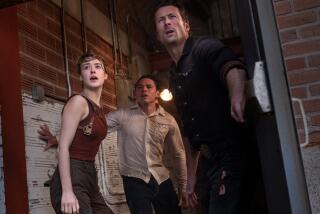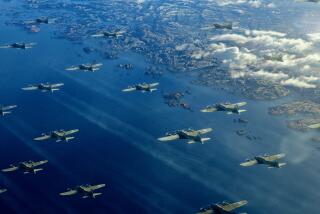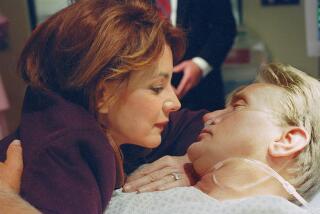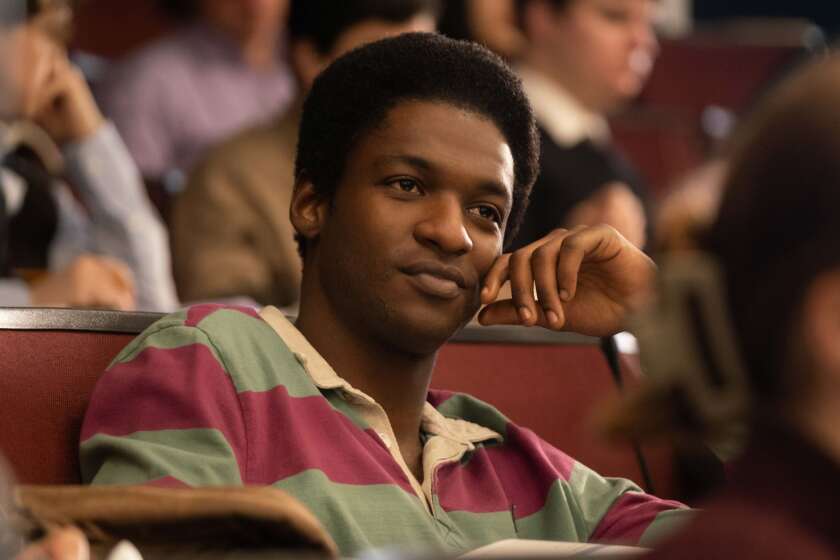‘Black Hawk’ Uplifts Military Crowd
WASHINGTON — A movie theater on Connecticut Avenue this week took on the jarring flavor of a combined Hollywood premiere and military officers’ bash. Cinema heartthrobs in T-shirts and leather jackets huddled with muscle-bound Delta Force and Ranger vets.
The seats held more brass than the Glenn Miller Orchestra: Defense Secretary Donald H. Rumsfeld, Army Secretary Thomas E. White Jr. and rows of beribboned generals and soldier heroes who sat with Josh Hartnett, William Fichtner and other actors who portrayed them.
Even Vice President Dick Cheney’s location was disclosed that night: the Uptown Theater.
The occasion was the Washington opening of “Black Hawk Down,” a film with a particular resonance in the five-ringed corridors of the Pentagon, where an open gash from the Sept. 11 terrorist attack remains--and where military strategists are plotting a return to Somalia, scene of the disastrous 1993 incident that gave rise to the best-selling book that inspired the movie.
“Black Hawk Down” is an unrelenting recounting of the botched U.S. attempt to nab several lieutenants of Somali warlord Mohammed Farah Aidid. The outcome was the destruction of two Black Hawk helicopters, the deaths of 18 Americans and the still-haunting scene of a dead U.S. soldier being dragged through the streets of Mogadishu by an angry mob.
Most of America finally gets the chance to see the $90-million movie this weekend, when it goes into wide release some weeks earlier than initially planned in order to capitalize on the nation’s current patriotic fervor.
The film benefited from unusually close cooperation between the filmmakers and the Pentagon, which saw “Black Hawk Down” as a way to reclaim the Somali disaster as a proud moment for the military.
The Pentagon can only hope that any new incursions in the terrorist haven of Somalia turn out better than the last one. But the film, like the book by journalist Mark Bowden, focuses not on the debacle but on the heroism of the soldiers put in harm’s way. It spotlights the Delta Force and Ranger troops who have played such a central role in the current campaign in Afghanistan.
In the film, Delta and Ranger soldiers stagger through Mogadishu’s maze of alleys, picked off one by one by Somali fighters who rocket past them in Jeeps, assault rifles blazing. The stunned Americans muddle through, drawing on each other for survival over a day and a night, uncertain if any of them can last until morning.
Not surprisingly, this depiction has won the unqualified praise of soldiers. That’s not always the case when Hollywood dons battle fatigues, although Sept. 11 has generally buffed up the relationship.
None of those at the premiere seemed able to find fault, certainly not a weeping Chief Warrant Officer Rodney “Sam” Shemp, who spent 18 hours in a helicopter during the Somali battle depicted on the screen.
“Powerful,” Rumsfeld declared.
“It was a very good portrayal of urban war fighting. It is like that,” said Sgt. Maj. Phil Prater, who served in Panama. “The training and the togetherness, the oneness, the teamwork in that type of environment was just shown through. You do rely on the person next to you, your battle buddy. And if you don’t take care of each other, nobody’s going to come back.”
The military and filmmakers both used the gathering to poke fun at war-spooked politicians. Sony Chairman Howard Stringer recalled his mid-1960s Army stint in Vietnam, while Army Secretary White mentioned the Army’s cooperation with the filmmakers, which allowed director Ridley Scott to film real soldiers and government-delivered Black Hawk helicopters on the Moroccan set.
Bowden said he wrote the story with little formal help from the Pentagon and carefully annotated it because he expected the military to criticize it.
“I wanted to make sure I constructed that book like a fortress,” he said.
But he also came away feeling the Pentagon had failed to convey its own story, leaving only the tarnish of a mission that resulted in the U.S. withdrawal from Somalia and a newfound military caution by a chastened Clinton administration. Many believe the U.S. flight from Somalia helped persuade Osama bin Laden, the alleged mastermind of the Sept. 11 attacks, that Americans had no stomach for war.
“The men who fought there, even though they were honored in the military, were tainted by the broader brush of failure,” Bowden said. “These military men and women did something very difficult and dangerous at a tremendous cost. And for them to be portrayed as bumblers and incompetents is deeply unfair, on top of all the losses they sustained.”
The tone of cooperation between the Pentagon and Hollywood was set when producer Jerry Bruckheimer arrived at the Pentagon office of Army Vice Chief of Staff Gen. John M. Keane and said, “General, I’m going to make a movie that you and your Army will be proud of.”
The Pentagon usually declines to help in movies made abroad. But this time it pulled out all the stops for a four-month shoot in Morocco, sending 139 soldiers from Ft. Benning, Ga., and Ft. Campbell, Ky., and eight helicopters from bases in Europe and the United States. Army aviators pilot the movie’s Black Hawk helicopter gunships. The soldiers shown rappelling from them were on loan from Ft. Benning’s 75th Ranger regiment. Last February, Hartnett, Ewan MacGregor, Tom Sizemore and a handful of other actors learned Army culture and weapon handling at Ft. Campbell and Ft. Benning.
The studio reimbursed the Army $2.2 million for soldiers’ transportation, food, housing and laundry.
More to Read
Only good movies
Get the Indie Focus newsletter, Mark Olsen's weekly guide to the world of cinema.
You may occasionally receive promotional content from the Los Angeles Times.










